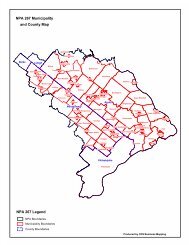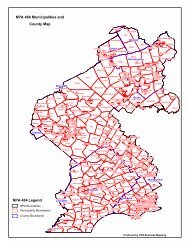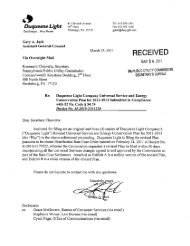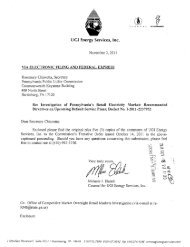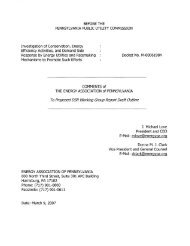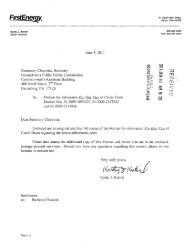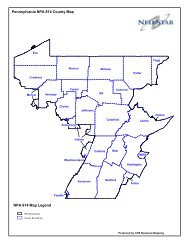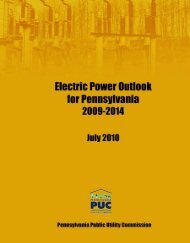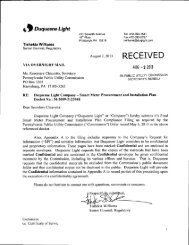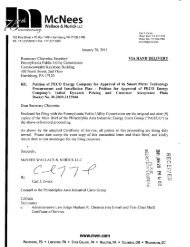METROPOLITAN EDISON COMPANY - Pennsylvania Public Utility ...
METROPOLITAN EDISON COMPANY - Pennsylvania Public Utility ...
METROPOLITAN EDISON COMPANY - Pennsylvania Public Utility ...
- No tags were found...
You also want an ePaper? Increase the reach of your titles
YUMPU automatically turns print PDFs into web optimized ePapers that Google loves.
Exhibit IX-3FE-PA CompaniesTotal Year-End Inventory Levels2006 – 2009Company 12/31/06 12/31/07 12/31/08 12/31/09Total Reduction2006-2009Met-Ed $12,503,178 $12,101,591 $10,799,975 $10,663,890 $1,839,288 14.7%Penelec $18,837,038 $15,705,265 $14,108,181 $13,428,474 $5,408,564 28.7%Penn Power $1,046,199 $722,763 $753,469 $916,281 $129,918 12.4%Total PA $32,386,415 $28,529,619 $25,661,625 $25,008,645 $7,377,770 22.8%Source: February 2010 Implementation PlanFirstEnergy indicated that inventory which is not considered as working inventoryis either transmission-related inventory or substation-related inventory. As of December31, 2009, the FE-PA Companies had approximately $9 million of transmission relatedand substation related inventory ($25,008,645-$16,013,855=$8,994,790). The turnoverlevel for this inventory has been less than 1.0 turns. Inventory turnover for totalinventory has been approximately 1.1 turns. Based on its efforts and experience gainedduring the years 2006 to 2009, FirstEnergy believes that it would be very difficult toachieve an inventory turnover rate of 3.0 for its working inventory because slow movingspare parts are included along with the active inventory items.FirstEnergy estimates that 58% of the FE-PA Companies’ working inventory, orapproximately $9.3 million, is slow moving (spare parts) inventory. The remainder of theworking inventory is actively managed inventory. FirstEnergy estimates that $2.0 - $2.5million of the $9.3 million in slow moving inventory represents excess usable parts onhand. FirstEnergy plans to reduce excess usable parts on hand by not replenishing theexcess portion of the inventory once it is used. This is a reasonable approach becausedisposing of such inventory now would expose the FE-PA Companies to the risk ofhaving to purchase spare parts when needed in the future at higher prices and possiblyextending outages. When work projects (i.e., capital improvements, etc.) slow down, asoccurred during the recent economic downturn, inventory levels can be lowered, but theCompany then risks stock outs if normal activity levels swiftly return. Also, a majorevent (e.g., a heat wave or an ice storm) could put the Company at risk of not havingthe necessary parts on hand, meaning a normal four hour restoration could take days tocomplete.FirstEnergy is comfortable with the inventory reductions achieved, but feels thatany further decrease would put the FE-PA Companies at risk of an inventory stock out(i.e., the inability to meet a demand due to lack of inventory). FirstEnergy indicated thatthe total materials and supplies inventory was approximately 1% of rate base for theFE-PA Companies as of December 31, 2009. Since the excess usable parts on handrepresent approximately 10% of total inventory, the Audit Staff estimates that theseparts represent only about 0.1% of rate base, or an immaterial amount.The FE-PA Companies annually review inventory levels for potentially obsoletematerials. A report on excess stock is generated by Supply Chain in order to search for- 56 -



